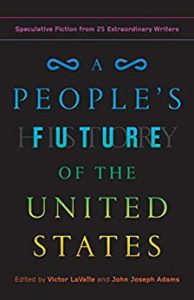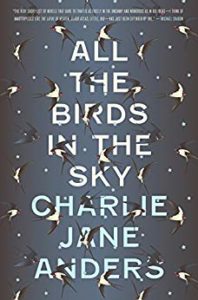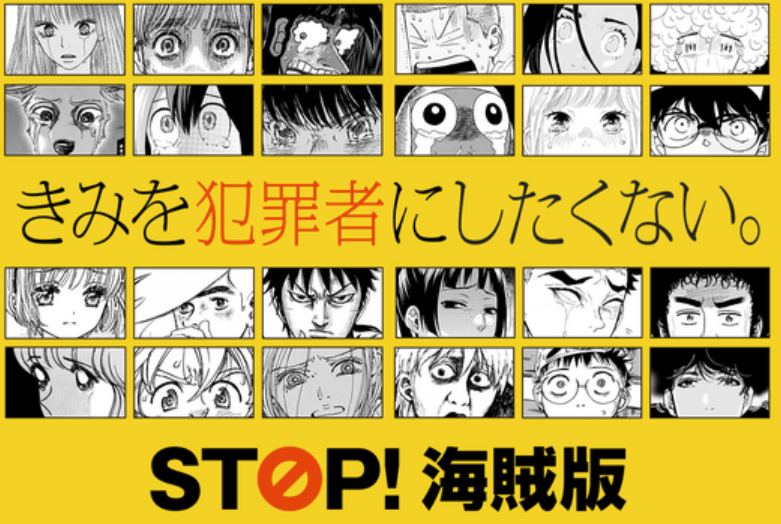Charlie Jane Anders—Nebula Award-winner and Hugo Award-winner, among other recognitions, and founding editor-in-chief of io9—released her second novel this month.
Following a trail of over 100 short stories and a multitude of essays in a multitude of top tier publications including Asimov’s Science Fiction, Mother Jones, Tor.com, Wired Magazine, and ZYZZYVA, not to mention a highly acclaimed and bestselling debut novel All the Birds in the Sky.
The City in the Middle of the Night takes a turn from Anders’ debut to deliver a heavy and elaborate tale of the tidally locked planet of January, where day and night are not times but places. The story revolves around four women whose lives entangle in complicated ways.
The City in the Middle of the Night is based on the premise of a tidally locked planet. What should readers know about tidally locked planets as foundational knowledge?
I’m super obsessed with tidally locked planets. I got obsessed with them several years ago when I was working on io9, because we did a lot of science coverage on that site. They’re really common in our galaxy, people have said maybe three quarters of the stars in our galaxy, at least, are probably red dwarfs, and any planet close enough to that star to be warm enough for humans to live on is going to be tidally locked.
So there’s a really high likelihood that we might end up—if we do ever manage to get out of our solar system and colonize another planet, which is a huge if, to be honest—there’s a huge likelihood that it will be tidally locked.
But a tidally locked planet is one where—it’s the same as the way our moon is with us—one side always faces the sun. It’s orbiting around the sun, but as it orbits it rotates at the same period. One side is always facing the sun, so there’s a day side and a night side, and the night side never gets any light, and the day side is constantly bathed in light.
As an author, I became obsessed with this idea of permanent darkness and permanent light, and what it would be like to have the day and the night be places instead of times.
I’m obsessed with the idea of people living between two extremes.
Part of what I was trying to imagine was, what it would be like to live in a place like that, where right over there is this never-ending darkness that goes on for forever, basically, and the idea that you just live with that nearby all the time, and you don’t ever see the sky change. I tried to imagine that, and what I ended up with after two years of just writing random stuff, was a really extreme environment, and people who are really extreme in response to that environment. And that was where the story came from. Part of it was just trying to imagine what it would do to you, to live with that.

Another theme that runs throughout the novel is language, and in particular, its limitations. It starts with a translator’s note talking about how they tried to fit the story into the English language.
My editor Miriam Weinberg came up with the term “Peak English,” because I had “modern English,” because I feel like that’s like English as spoken now, or like late 20th century maybe. But she was like, “How about ‘Peak English’?” Because that implies that there was a point at which English reached the zenith of its importance, and I like the idea that at some point even beyond the timeline of this book, there’s humans—humans and human-adjacent people—living on places like space stations and planets all over the place, and everybody speaks different languages, but we can all read English because there’s so much stuff written in English that survived.
So it’s like Latin in the Middle Ages where no one—well, some people could speak Latin—but a lot of people could read Latin. Or classical Chinese in some parts of Asia.
The Translator’s Note is partly a way of getting around having weird names for things that would be unusual, because I thought if you actually were reading the transliterated names, the creatures and the technologies and devices and everything, it would be distracting versus just being like, “it’s a cat, it’s a bison, it’s a leopard, it’s a crocodile.”
It was such a fun recurring thing in the novel, because you start thinking “crocodile” and then it comes out with its tentacles, and you’re reminded, wow, this is not a crocodile. This is something really fascinating and beautiful, and super dangerous and it is totally not a crocodile.
But it does reinforce, over and over again, this limitation of language, and of experience.
And I love that de-familiarization and I love the opposite of the way that. Vonnegut, for example, will be like, “the United States was a country that used to exist in the global bond”—he’ll explain the United States of America to you in a couple of sentences as if you’ve never heard of it. And it’s sort of the opposite of that because it’s saying this is familiar, but it isn’t.
Sophie, in particular, struggles throughout a lot of the book with talking. She doesn’t want to spend a lot of time talking. But language is so limited to her that she doesn’t even see much point in it a lot of the time.
I had gotten bored always writing protagonists who are outspoken, and rush into every situation and start talking—the thing that every action movie or every inspiring hero’s tale where the hero at some point stands up and gives a speech, and everyone is is just like, “yay!”
I wanted to try to write a protagonist who wasn’t like that, who was shy, who was withdrawn, who didn’t talk to people and never really felt comfortable with them—but was still super heroic and still takes charge in her own way, and her choices still drive the story completely. And that was something I was super passionate about trying to do because I thought, I’ve seen that other protagonist the kind of like, give a rousing speech protagonist, and I’ve written that protagonist a lot. And so I was like, you know, it’s interesting to try something different.
In general with this book, I was trying a lot of ways to do stuff that I hadn’t done before, because I want to keep it fresh for myself and hopefully for my readers.
There’s so much incredibly rich history behind the different cultures. And along with that, there’s a tie specifically to what we remember and what we forget, or choose to forget.
I hate it when you have a future setting where humans are on a different planet, or in a different place, and it’s a blank slate—like, oh yeah, you know there is all this stuff back on Earth, but we’ve left it behind. There’s only cheesy references back to like 20th century stuff or whatever, like they still have Mickey Mouse icons everywhere or something.
I wanted people to have a sense of history, but not have it be like the history we know now, to have to it be history that hasn’t happened yet. And I wanted to think about what people brought with them to this other planet.
I wanted there to be a believable sense of cultural background, and not just have people who are all the same except for maybe their skin color is mentioned in passing or whatever. A lot of it does come down to the weight of history, and how history never really goes away.
And so I spent way too much time coming up with this huge history.
What about the ankur-banter, or jinx, concept—where did this concept come from?
It just came out organically. As I was writing, I was like sliding in all these references to different cultural concepts in Argelo that people from Xiosphant would find confusing—and there’s always gonna be some of those; whenever you go to another culture there’s going to be concepts that are really culturally specific, like schadenfreude, or whatever.
I liked playing with that mystery, and then I suddenly came up with this idea of what it could actually mean and how it could shift this relationship between Sophie and Mouth in a different direction, and suddenly put them in this different relationship to each other and make them kind of bound together in a different way, which I thought was really fun.
I have so many influences that I’m wearing on my sleeve in this book; I’m just coming out and admitting that I’m influenced by these people and I’m stealing from them as much as I can. Vonnegut has this whole thing in, I think it was Cat’s Cradle, I can’t remember, where there’s like this weird philosophy of bokononism and one of these things is, people who are entangled who never meet, or something. But I read it like when I was super young, and that’s stayed with me. So I think I was cribbing from Vonnegut a tiny bit, but also this idea that you have somebody who is bad luck for you, unless you make peace with them, or that you have to figure out how to live with them, and I thought that was really fun.
You have published over a hundred short stories in your writing career, and the first was published in 1999—so it’s been a 20-year span.
 That’s a little scary to contemplate. But no, I’ve been writing fiction for a very long time. Six Months, Three Days appeared in 2011 or something, so it took probably about a dozen years for me to really start getting on the map as a fiction writer.
That’s a little scary to contemplate. But no, I’ve been writing fiction for a very long time. Six Months, Three Days appeared in 2011 or something, so it took probably about a dozen years for me to really start getting on the map as a fiction writer.
And it was really funny, after Six Months, Three Days came out and started getting nominated for awards, people would come up to me like, “I didn’t know you wrote fiction” and I’d be like, “I’ve been trying really hard.” And it was sad but it was also really gratifying that people were finally aware that I wrote fiction.
When it comes to art, I always think you are what you eat. So do you read a lot of short stories? What would you recommend to readers who wanted to read more short stories (besides your own work, of course)?
I haven’t read a lot of short stories lately, and I really want to change that. These days, I get up, I eat my breakfast and I read the news, and basically get sucked into a despair spiral for an hour or so, reading about what’s going on.
I love short stories, and I feel like they’re often where a lot of the most interesting stuff is happening.
It’s really true that there is where the most experimental stuff is often done because there’s less risk, and if you read a short story you didn’t like, it’s not as upsetting or annoying as if you actually went out and bought a book and didn’t like it.
And right now I feel—I don’t know if it’s the golden age, but it’s definitely an amazing time to read these short stories, because there’s so many online publications.
Even just 10 years ago—there were a bunch 10 years ago—but now I feel like it’s really proliferated, and there’s so many great places like Tor.com or Uncanny Magazine, Lightspeed, Clarkesworld, Strange Horizons, and a bunch of literary publications online as well.
 And not only that, but there’s a lot of great anthologies. I feel like it’s a really good time for anthologies, like John Joseph Adams is releasing a bunch lately. I have a story in a new one called A People’s Future of the United States, and I really want to read the rest of that book because I hear that the other stories in that book are incredible, and it’s got a lot of my favorite authors in one book.
And not only that, but there’s a lot of great anthologies. I feel like it’s a really good time for anthologies, like John Joseph Adams is releasing a bunch lately. I have a story in a new one called A People’s Future of the United States, and I really want to read the rest of that book because I hear that the other stories in that book are incredible, and it’s got a lot of my favorite authors in one book.
There’s a lot of really great anthologies dealing with political themes and what future we can have, and resistance and war and fighting back, and People’s Future is a really good one.
I’ve seen mentions of a young adult trilogy that you’re working on. What can you tell us about it?
 I’m super excited about it. It’s very fun and silly and goofy. There’s lots of humor. It’s more cute, and it’s about people coming together and creating an unconventional family, and being there for each other. It’s much lighter and happier than The City of the Middle of the Night—which, actually, I was working on them together, simultaneously for a while.
I’m super excited about it. It’s very fun and silly and goofy. There’s lots of humor. It’s more cute, and it’s about people coming together and creating an unconventional family, and being there for each other. It’s much lighter and happier than The City of the Middle of the Night—which, actually, I was working on them together, simultaneously for a while.
It was nice to go back and forth, but I’m really happy to be doing something like that now, because I really feel like a lot of us need that escapism and fun. It’s kind of a space opera. It’s got a little bit of a Guardians of the Galaxy, Star Trek, Star Wars feeling.
It’s about a teenage girl who finds out that she is connected to this galactic war that’s been going on, and this fight for justice, and so she goes into space with this group of other teenagers from Earth, from all over the planet, to help fight for justice. I came up with super, ridiculous complicated universe building for it. There’s a dozen different alien species that I have come up with, a whole bunch of really awesome, fun stuff.
One of the main characters is a transgender girl from Brazil, and so I’ve been Skyping a lot with a trans woman in Brazil, and she’s my sensitivity reader, or one of them.
It’s been really really neat. I’m super excited. I have a feeling it’ll be out sometime in 2020.
Source : Charlie Jane Anders On The City in the Middle of the Night













